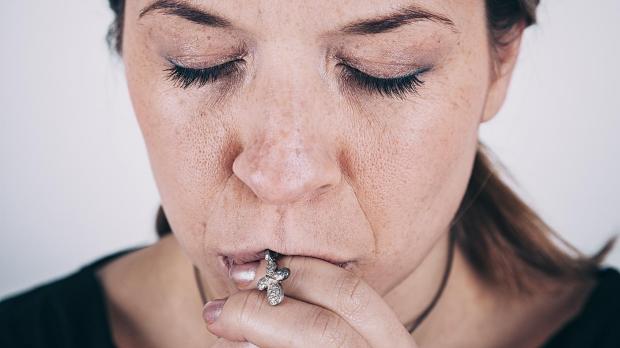Lenten Campaign 2025
This content is free of charge, as are all our articles.
Support us with a donation that is tax-deductible and enable us to continue to reach millions of readers.
We were always kissing things.
Growing up in an ethnic Catholic neighborhood full of large families and clumsy kids, it was not unusual to see people pressing their lips against many things besides dogs and people. Let someone knock over a kitschy plastic glow-in-the-dark St. Jude and it would be placed back on the shelf with a quick kiss. Should a lady drop her rosary as she changed purses, there was a kiss and then a tuck into a safe satin pocket. Once, when a neighbor pulled change from his pocket, a small crucifix dropped to the curb; it was openly kissed before disappearing back into shabby brown gaberdine. My own devout grandmother — a convert from Lutheranism — would not hesitate to get on her knees and kiss the floor where holy water had spilled. No wonder the sole Protestant family on our block thought we were not just eccentric, but possible idolators to boot. No wonder that even today, when statue-kissing has gone out of vogue and few homes keep holy water around, many people cannot tell the difference between Catholic worship and mere reverence — between adoration, which is reserved for God, and veneration, which is merely reverence, albeit mixed with awe. The Communion of Saints must seem strange to outsiders who wonder why Catholics and Orthodox Christians bother taking side roads in their orisons when a prayer to Jesus seems like a faster, more direct route. As a religious sister from my childhood put it, though, “Why be singular when you can participate in heaven?”
We participate in heaven, in a manner of speaking, at holy Mass. I’ll never forget my younger son’s wide-eyed delight in learning that “Holy, Holy, Holy, Lord God of Hosts” unites us to the chorus of continual praise offered by angels in the presence of the Creator. That information kept him bellowing at Mass for some years, until he realized that, to Eternity, a whisper works as well as a wail.
In St. Paul’s great Cloud of Witnesses we access our ancestry; we keep images of holy men and women about us, as would do with beloved members of the family. Believing in eternal life, and that Christ meant it when He said He was preparing a place for us, it seems a no-brainer to ask these distant-yet-near relations for their intercessory prayers.
Beyond the prayerful assists, and the relics and mementos that inspire us and help train our attention, Catholics and Orthodox Christians benefit from the wisdom of those who have traveled this vale of tears before us, struggling with the same sorry sins we battle today — lust, avarice, anger, sloth, pride, gluttony, envy and despair. Their advice echoes down to us through the ages with a resonating surety as, like professors in a spiritual university, they give real instruction on a range of subjects.
In theology: “The Father takes pleasure in looking upon the heart of the most holy Virgin Mary, as the masterpiece of his hands.… The Son takes pleasure in it as the heart of His Mother, the source from which He drew the blood that … ransomed us.” — St. John Vianney
In practical humility: Once Macarius directed a young seeker to go to a cemetery and upbraid the dead. Then to go and flatter them. “What answer did they dead give you?” Macarius asked. “None at all,” said the youth. “Then go and learn never to let abuse or flattery move you. If you die to the world and yourself, you will begin to live for Christ.”
In suffering’s value: “During painful times, when you feel a terrible void, think how God is enlarging the capacity of your soul so that it can receive Him — making it, as it were, infinite as He is infinite. Look upon each pain as a love token coming to you directly from God in order to unite you to Him.” — Saint Elizabeth of the Trinity, (who taught me how to pray…)
Whether they are memorialized in icons or dangling from keychains, who wouldn’t want to kiss such profound teachers as these?

